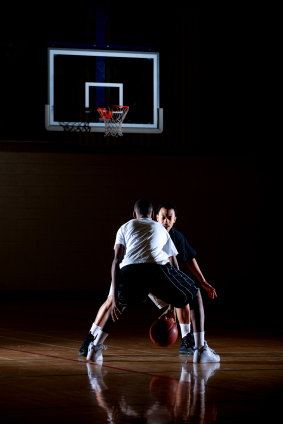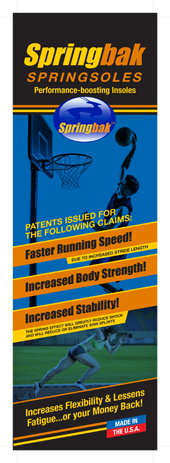Archive for Blog
Springbak Speed Training Skills – How To Quicken Your Stride Frequency For More Speed
Posted by: | CommentsSpeed is perhaps the most coveted component of athletic performance. Whether you are a football player looking to better your 40 yard dash times or a marathoner who’s looking to improve your distance time, the importance of foot speed in running is unquestionable.
Our patented Springbak Springsoles will accomplish both increased stride frequency and increases stride length.
Traditional thinking dictates that to be fast, choose your parents carefully. In other words, speed is a genetic trait. While this is true to the extent that it is not possible to be a world-class sprinter without genetic endowment, sport science and proper coaching have done much to refute this.
Speed is a learnable skill that can be taught through motor-learning principles. Ultimately, it is only through the practice (repetition) of these motor skills and proper training that any genetic endowment can reach its highest potential.
There is an old axiom: “I hear, I forget; I see, I understand; I do, I remember.” The more you do something, the better you become at it.
Speed Made Simple to understand:
Although the actual physical components of running speed are rather complex, we’re going to keep things simple. Speed is produced by stride length (distance covered with each stride) and stride frequency (leg turnover time, or how quickly you can get your feet on and off the ground).
Of these two components, stride length is the easiest to develop and is also the most misunderstood. Stride length is not created by how far you can reach forward with each step, but rather by the amount of force you apply to the ground (with the foot striking directly under the hip) and driving back. Our Springbak Springsoles will increase the force you apply to the ground, thus a longer stride length.
Speed is created through the ground, not the air. Once the foot touches the ground, it drives rearward, creating a springboard effect that propels the body forward. Most people are slower than they should be because they pull out of their stride length too early, not allowing the foot to remain on the ground long enough to drive the leg completely straight behind the body, thereby maximizing the force and distance necessary to propel the body farther forward.
Let’s quickly look at two basic mechanical principles that should be considered for proper running form:
Step 1: Keep Your Head Steady:
Head position is critical in athletic performance. Your head should be still during sprinting. We use the term “focus” to mean your eyes should be straight ahead, as if you’re looking at somebody your height in the eyes. Remember, you go where your head goes.
If your head is moving side-to-side, your body is going to be subject to lateral forces that negate from the objective: moving straight ahead. You should run relaxed; you’ll hear track coaches say “Jaw down, shoulders down.” The human head generally weighs between 11 and 14 pounds. Keep this “bowling ball” (your head) in the proper postural alignment: centered between the shoulders.
Step 2: Keep Your Arms Fixed at a 90-degree Angle:
Why? To use the strong muscles of the shoulder girdle to create optimum force. Never run with tight, clenched fists. This will tighten you up and slow you down. Keep your thumb and forefinger in contacts or run with an open palm, whichever you are most comfortable with. Your elbows should be squeezed in to the sides of the body.
Try this: Stand up and put your left hand on your left hip. Move your right arm across your body. Did you notice how your left hip moved? The body is a system of levers and, to simplify matters, what you do with one arm will affect the opposite leg. If your arms cross in the mid-line of your body when running, your hips will rotate in, thereby taking away from your force output and creating rotational forces that minimize your speed.
Enjoy the speed training tips!
Mark Vona – GM Springbak Inc.
_______________
For more tips and information from Springbak:
Visit the Official Springbak® Website at www.springbak.net
Peak Performance Springsoles / Insoles – Run Faster, Jump Higher, Lessen Fatigue
Find us on Facebook: www.facebook.com/springbak
Follow us on Twitter: www.twitter.com/springbak
Friend us on MySpace: www.myspace.com/springbak
Tune in on YouTube: www.youtube.com/springbakinc
Springbak Training Tips: How To Prevent Injury and Improve Performance
Posted by: | Comments Athletes, especially athletes who play sports which require changes of direction and landing from explosive jumps (soccer, basketball, track and volleyball), must train to prevent injury first, and build to improving one’s performance.
Athletes, especially athletes who play sports which require changes of direction and landing from explosive jumps (soccer, basketball, track and volleyball), must train to prevent injury first, and build to improving one’s performance.
Today’s athlete needs to train the lower body for strength and balance and train the core muscles. “Core Training” is a popular buzz-word in the fitness industry and it means different things to different people; however, training the core musculature – the muscles of the abdominal, lower back, hips, pelvis, quadriceps and hamstrings – improve overall strength. For instance, a boxer throws a punch, he used his upper body; however, his power comes from his lower body. The core is the region that transfers the power from the legs through the upper body. With a weak core, the boxers punch lacks power. The same is true of almost every athletic move… just think about that one.
World class athletes, coaches and trainers use Springbak Springsoles in their athletic programs for performance and injury protection. The Springsoles provide you a competitive edge and absorb shock as well. The Springsoles will increase your stride length when you run, and increase your stride frequency (shorten foot plant time) as well as give your game much more balance and stability: What people are saying about Springbak Springsoles.
How can I increase my vertical jump?
We get this question all the time, here’s how:
The best exercises for increasing your vertical jump are squats, lunges and step-ups. These are the best because they are compound movements, which work the knee joint and the hip joint at the same time…Squats are the best exercise an athlete can do for strength if it is performed correctly.
Great tips on lunges:
Lunges are another great body exercise. Once the athlete learns the movement pattern of lunges in different directions-front, backward and side lunges, they can then use weights in the hands for a more intense workout and challenge your neuromuscular system. Also, the athlete can add different elements to the lunge. A simple addition to work the shoulders to use the medicine ball to do a lunge and press. Additionally, a lunge and reach is a good exercise.
Please comment, as we welcome your tips and advice as well.
_____
For more tips and information from Springbak:
Visit the Official Springbak® Website at www.springbak.net
Peak Performance Springsoles / Insoles – Run Faster, Jump Higher, Lessen Fatigue
Find us on Facebook: www.facebook.com/springbak
Follow us on Twitter: www.twitter.com/springbak
Friend us on MySpace: www.myspace.com/springbak
Tune in on YouTube: www.youtube.com/springbakinc
Springbak Volleyball Conditioning Drills: What Kind of Training is Needed?
Posted by: | CommentsStrength/Power Training – How to Gain Strength for Volleyball?
 Beginning volleyball players are able to gain strength by working out with the body weight, but in order to get to the next level athletes need to start weight training.
Beginning volleyball players are able to gain strength by working out with the body weight, but in order to get to the next level athletes need to start weight training.
One of the best methods to get strength is the basic weight training in the gym. Traditional weight lifting exercises like squats, deadlifts, clean and jerk, snatches, bench press and all the variations of them are great exercises for volleyball players.
Weight training doesn’t necessary mean traditional weight lifting. It could include training with medicine balls, kettle bells or any extra weight you can imagine.
Pure Power Alone Is Not Enough
Pure power and strength alone doesn’t carry very far on the volleyball court – volleyball players also need endurance, agility and quickness on the court.
Being Explosive and Quick Is Important
When working out it is extremely important to keep in mind what qualities is needed in volleyball.
For example being explosive and quick is important for volleyball players, therefore an athete should always have explosive power training or quickness training in the training schedule.
Volleyball Conditioning Drills – Endurance Training
What kind of conditioning is needed in volleyball?
Let’s think about the volleyball match – each rally is about 5-15 seconds long, following with 5-10 second break between the rallies. Wouldn’t it make sense to practice endurance in that context?
Therefore traditional cardio, like long distance running is probably not the best training for volleyball endurance. It will surely increase athletes’ VO2 max, but still there is a better way..
Engage athletes for example in plyometrics training (low impact jumps, footwork drills, ladder drills, dot drills, etc.), in which athlete works that 5-15 seconds intensively, then having a little 5-10 break between each rep. That kind of training makes athlete work out with the same energy levels than needed in volleyball.
Surely you could add also higher intensity interval training into the mix – making athletes taking for example 15 second sprints following by jogging/walking before doing another sprint. You could make that happen on the volleyball court by running volleyball suicides – making sure athletes have to change direction often, just like in the volleyball match.
Volleyball Conditioning Drills – Agility Training
How to get quick feet and become fast on the court?
Plyometric exercises involve usually to short and quick movements, which athlete performs often with own body weight in a circuit type of training.
Plyometric exercises are great way to improve agility and help athletes to change direction quickly.
Ballistic training is very close to plyometrics training and often referred as plyometrics. Explosive push ups, squat jumps, frog jumps, medicine ball throws are ballistic or plyometric exercises which are excellent for volleyball players.
Next week we will cover Spiking Fundamentals : by Hugh McCutcheon, head coach USA Volleyball
_____
For more tips and information:
Visit the Official Springbak® Website at www.springbak.net
Peak Performance Springsoles / Insoles – Run Faster, Jump Higher, Lessen Fatigue
Find us on Facebook: www.facebook.com/springbak
Follow us on Twitter: www.twitter.com/springbak
Friend us on MySpace: www.myspace.com/springbak
Tune in on YouTube: www.youtube.com/springbakinc
Springbak Basketball Training Tips – Driving to the Basket
Posted by: | CommentsArticle by William Crow – Former Professional Basketball Player / Chairman Springbak Inc.

When you drive to the basket you must normally beat two people. The first is the man that is guarding you. The second is the big man guarding the basket. How to beat the man guarding you was covered in a previous blog. The concentration here will be how to beat the big man guarding the basket. Remember driving to the basket is the best way to get to the foul line!
Here are some tips on driving to the basket:
1. Accelerate your last two steps.
2. Remember that your momentum will carry momentum on the basketball toward the basket – so flip the ball straight up in the air when accelerating to allow your momentum to carry the ball to the basket.
3. Accelerate toward a spot on the backboard away from the big man defender.
4. Flip the ball HIGH on the backboard with soft backspin so the basketball will drop down into the basket, not careen the ball off the backboard.
5. Put the ball up quick, before the defender can react. Our Springbak Springsoles will give you quicker reaction time and a quicker release. Keep a short shooting stroke, this technique was covered in a previous blog post as well.
6. If the defender is near the basket you have the option to drive past the defender and bring the basketball back to the basket off the backboard with spin.
7. Remember you have obstacles on your side:
a. One obstacle is the basket itself. If you can jump high enough to extend the basketball above the basket, the rim will act as an obstacle to the defender.
b. Also, use your body often as an obstacle. Keep your body between the basket and your defender, controlling the basketball with spin off the backboard. If the defender goes through your body to block the basketball, you will most likely get to the foul line.
c. A third option is to make contact with your body to the body of the defender going up to block your shot. After contact, regain your balance then shoot. This is another trick that will probably get you to the foul line.
Have fun and enjoy the basketball tips – William Crow / Chairman Springbak Inc.
—
For more tips and information:
Visit the Official Springbak® Website at www.springbak.net
Peak Performance Springsoles / Insoles – Run Faster, Jump Higher, Lessen Fatigue
Take Your Best Shot in the Springbak 2010 NBA Playoff Finals Prediction Challenge
Posted by: | CommentsIt’s time to take your best shot in the Springbak 2010 NBA Playoff Finals Prediction Challenge!
Springbak Inc. wants your predictions in the 2010 playoff finals series – Comments, thoughts, opinions and answers from both Laker fans and Celtic fans alike!
Springbak will be giving away One Pair of Springbak Springsoles AND a Springbak T-Shirt to the one person who predicts the outcome of the series the closest.
Your goal is to predict:
1) How many games the series will go
and
2) How many points the winning team will beat the other team by in the last game
We look forward to your comments and good luck to everyone that answers this post!
Only one vote/comment per e-mail address please.
To be eligible to win, comments must be submitted to this blog post prior to the start of the Game 4.
So, who will take the title this year?
Have fun and GOOD LUCK!
For more information:
Visit the Official Springbak® Website at www.springbak.net
Peak Performance Springsoles / Insoles – Run Faster, Jump Higher, Lessen Fatigue























